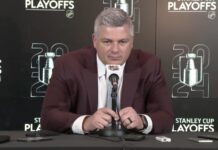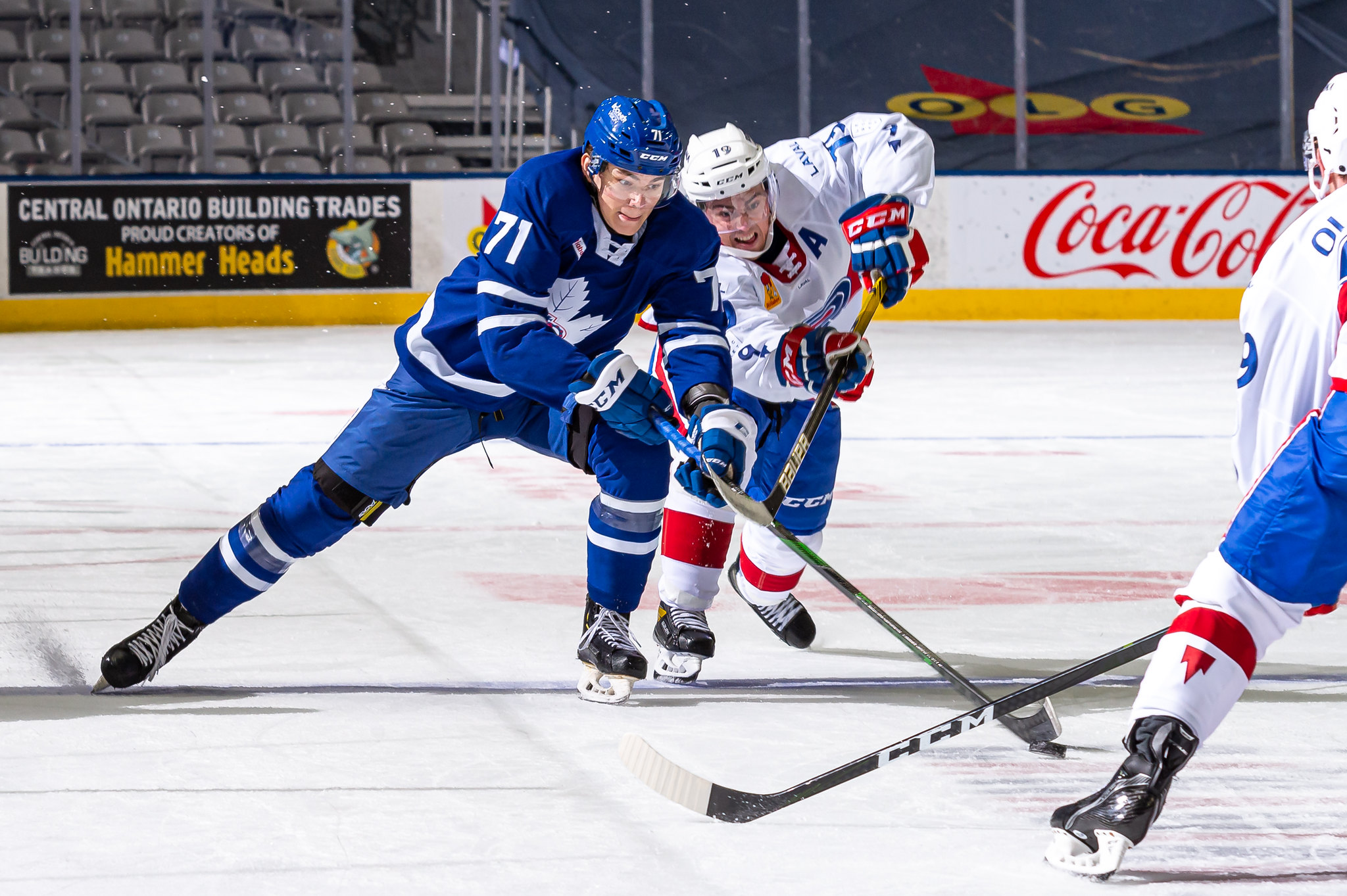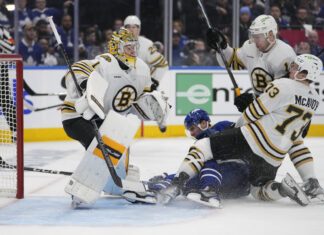How to analyze the Toronto Marlies’ 2020-21 season is a question I have been wrestling with since the season’s end.
After the Canadian Division started play later than the rest of the AHL, not only did they begin their campaign with a long road trip, but they also dealt with an enforced three-week break due to COVID protocols. The Marlies ended their shortened season with a hectic schedule that saw them play 13 games inside 20 days through May.
The final record of 16-17-02 would have been considerably worse if not for some heroic goaltending performances at the end of the year that accounted for five victories and an OT loss.
The AHL is a development league, albeit with the caveat that Toronto management values a winning environment and playoff experience for their prospects. You have to go back to the 2009-10 season to find the last time the Toronto Marlies posted a losing record.
Results notwithstanding, this season was a very disappointing 35-game sample. Performances were at times lackluster if not inept, with an apparent lack of cohesion, which in part you can attribute to an ever-changing roster. However, the overwhelming feeling was that a disconnect existed between the players and the coaching staff.
Whatever the actual problems, the result was some catastrophic performances and many big-margin defeats. Toronto was shambolic defensively, and there was a lack of structure with and without the puck. The ever-changing cast of Marlies‘ goaltenders were often hung out to dry, frequently dealing with odd-man rushes, breakaways, and missed assignments.
Toronto allowed at least four goals in a single game on 17 occasions, almost 50% of their schedule. In nine of those games, Toronto conceded five or more goals.
While it’s not all of his own doing, Greg Moore’s tenure to date has been problematic. Taking over from Sheldon Keefe for two seasons cut short by the pandemic makes for far from ideal circumstances. This is fundamentally a results business, though, and a 29-36-4 record doesn’t cut it.
There has been little in the way of accountability on both sides of the counter when it comes to how players have been treated during Moore’s time in the organization. Many veterans have continued to hold down a spot in the lineup when their performances haven’t warranted it. On the flip side, those who have thrived in the ECHL and earned a callup haven’t always earned a fair shake.
Younger players on the roster were not always rewarded on the whole for good performances or struggled in limited minutes playing in roles that weren’t suited for them. Justin Brazeau and rookie Riley McCourt are two names that spring to mind in that respect.
Special teams were also little to write home about in 2020-21.
The power play connected at 16.9% and ranked 22nd in the league. Toronto never seemed able to cope with personnel changes on the man advantage, badly missing Nic Petan and Kenny Agostino when the pair were reassigned to the Taxi Squad.
The penalty kill fared better, ranking 11th at 82.3%.
New General Manager Ryan Hardy opted to release Assistant Coach Rob Davison as a free agent and promoted Newfoundland Growlers Head Coach John Snowden, which speaks volumes. The result could be that Greg Moore is on a short leash, but that’s a topic for another article.
Just how do you assess player performances in an AHL season like no other? The Toronto Marlies iced 48 players in 35 games, with only 20 players suiting up in 20 or more games. I am not going to grade players or go through the entire roster. Instead, here are some thoughts on a collection of notable players (for various reasons) in 2021, starting between the pipes.
Goaltenders
The Marlies‘ goaltending situation was without doubt the most frustrating part of their season for me.
Ian Scott was ruled out through injury for the majority of the season. When finally healthy, his one game was nothing to write home about.
Andrew D’Agostini was a nice story and everybody was thrilled to see the former Peterborough Pete realize his AHL dream. However, after a strong start, he inevitably regressed to what he is — namely, an ECHL starter — with his struggles coinciding with a lack of support from the team in front of him.
Numbers never quite tell the whole story, and they certainly don’t in Joseph Woll’s case. His save percentage statistics look like a wild rollercoaster, but much of it was due to how the team played in front of him.
If he wasn’t on his A-game, Woll was likely going to be shelled and ultimately pulled by Greg Moore, who even called the goaltender out in a post-game presser on one occasion. It was the sole time Moore did this throughout the season to any player, so make of it what you will.
Woll produced four standout performances in 15 games beginning with a 23-save shutout against Belleville. Late in the season, Woll stood on his head against Laval and earned the Marlies three wins with 57, 36, and 27-save performances.
Defensemen
Timothy Liljegren
Liljegren was head and shoulders the best defenseman on the team across all three zones. He was Toronto’s MVP despite playing just 21 games.
There were points in games where he would take control by orchestrating a solo breakout, creating spells of offensive zone time for Toronto. He took more responsibility offensively, averaging almost 2.5 shots per game, well above his career average. His production did not compare to 2019-20, but given a longer season of play, I am convinced he would have inched closer to 0.75 PPG, if not better.
Timothy Liljegren big time fake and set-up for Pavel Gogolev's powerplay goal, to the immense dismay of Laval's Jordan Weal pic.twitter.com/51HxDAvUl2
— big time fan of hockey, the least stupid of sports (@mostlyleafies) May 12, 2021
Liljegren proved that he is too good to linger in the American League any longer. Leafs brass now has to decide whether to give him an extended NHL opportunity.
Timothy Liljegren finishes off a great offensive zone shift with a one timer blast for his second goal of the season. #LeafsForever pic.twitter.com/7KXsUlcojz
— Nick Richard (@_NickRichard) March 29, 2021
Teemu Kivihalme
It was a strange season for the Finnish blueliner, who found his touch offensively with six goals and 11 points through 20 games.
In my mind, he regressed defensively, which was previously a strength. His gap control was repeatedly poor and he regularly got caught napping by an opponent more fleet of foot. There were also inexplicable brain farts in his own zone.
I am not sure what to make of the 26-year-old defenseman at this stage of his career. The NHL looks further away than it did two years ago for him.
Mikko Kokkonen
Kokkonen was like a deer in the headlights through his first two AHL outings. After finding his feet, he showed glimpses of why Kyle Dubas selected him 84th overall in 2019.
Kokkonen was thrust into top pair minutes and responded relatively well considering he was joining a struggling team. He was brave and bold enough to trust his offensive instincts when carrying the puck or judging when to jump into the play.
The Finnish defenseman recorded seven points in 11 games along with his first AHL goal.
🚨 FIRST 🚨#MarliesLive pic.twitter.com/s30biDZPsi
— Toronto Marlies (@TorontoMarlies) May 12, 2021
Five of his seven points were primary, which is an encouraging statistic at this tentative stage. Toronto now has to decide whether the AHL or Europe is a better place for him to develop.
Joseph Duszak
Duszak ranked ninth on the team in scoring (4-8-12) and tied for eighth in even-strength points (10). His offense and willingness to play with an edge — which included going toe-to-toe with Brendan Gallagher at one point of the season — were high points in an otherwise difficult season.
Martin Marincin with the pass, Joseph Duszak with the goal.#Marlies tie the game at two. pic.twitter.com/iTOiUOm6Hv
— Nick Barden (@nickbarden) May 1, 2021
The defensive side of his game fell apart as his decision-making with and without the puck in his own zone was lacking. The NHL feels like a long shot for Duszak at this point.
An important season ahead will determine if he’s qualified and re-signs in Toronto.
Mac Hollowell
Hollowell has a lot of work to do in 2021-22 to make Toronto’s top brass take note. He is a diminutive defenseman who has to learn to make smarter decisions defensively to make up for his lack of physicality and size.
He finished the season stronger than he started, but the offense dried up compared to his rookie year. We will see if he takes what he learned from his time on the taxi squad and applies it next season.
Noel Hoefenmayer
Skating remains his largest obstacle in climbing the hockey ladder for Hoefenmayer. One of seven rookie blueliners on the team, the 22-year-old struggled with consistency and appeared in just 18 games.
The former Ottawa 67 might have been a good power play option if afforded the opportunity — his booming shot could have been a potent weapon with the extra man — but he was deployed only on the penalty kill.
All of his six points were registered at 5v5 play, and he found the net twice despite registering only 13 shots on goal.
Just because I love this kid and it was a pretty nice first AHL strike.
I present you with Noel Hoefenmayer's first professional goal! pic.twitter.com/fU1RFjYLKW
— Mark (@MarkUkLeaf) May 5, 2021
Filip Kral
Kral suited up for 10 games with the Marlies after starting 2020-21 in the Czech League. He was defensively sound, especially off the rush, and his skating ability surprised me in a good way.
While not touted for his offense, he even notched a couple of even-strength goals.
Wasting no time.#MarliesLive pic.twitter.com/P2WqUMkF1q
— Toronto Marlies (@TorontoMarlies) May 20, 2021
This is a player to watch in 2021-22.
Forwards
Before we dive into the forwards, a note on Nic Petan, Kalle Kossila Kenny Agostino: All three were excellent contributors during their time with the Toronto Marlies on the ice and as leaders. Good luck to the trio in the next step of their careers.
Nick Robertson
I will preface this by saying I am not as high on Robertson as many observers, pundits, and fans are at this stage of his development. He needs to get stronger and become more difficult to knock off the puck. Too many AHL defenders have effectively neutralized Robertson by playing physically against the rookie.
The left-winger also developed a tendency to skate into dead-ends aka Kasperi Kapanen. This was especially prevalent when Toronto was struggling to create offense and he tried to take it on himself to carry the load.
In short, I believe Robertson requires more time to develop in the American League. His professional career has been stunted by the pandemic — he has suited up for just 10 games in the NHL and 21 in the AHL.
Excellent puck recovery from Nick Robertson then a heads up play to find Adam Brooks.
Also like how Tyler Gaudet wastes no time in getting a shot off and Brooks crashes to the net to score. pic.twitter.com/PCWMPUArWr
— Mark (@MarkUkLeaf) March 3, 2021
Robertson registered 16 points in 21 games through the 2020-21 campaign. Two of his five goals were power-play tallies and he finished the season strongly by recording a point in six of his last seven outings.
Semyon Der-Arguchintsev
I wish we had gotten to watch a little more of SDA. Nick Robertson is noted for his work rate and strong forecheck, but SDA showcased his willingness to do the dirty work that isn’t necessarily associated with his reputation.
He played in just six AHL games but never showed any fear as a rookie. SDA was happy to take risks and make plays offensively, almost to the point where he was trying to do too much on occasion.
That is a trait I am not adverse to at this stage of his career.
Tying goal by Kalle Kossila.
SDA looks a natural out there and records his second primary assist in as many games. pic.twitter.com/T8HM4woFzY
— Mark (@MarkUkLeaf) April 1, 2021
Four points in six outings included three assists on the power play, where he could utilize his creativity.
Some work in the gym to become a little bulkier and stronger is required but not to the detriment of his skating.
In all, there is a lot to be encouraged about from his spells in the KHL and AHL.
Joey Anderson
Injuries limited Anderson to 20 games, but he produced exactly what I expected of the RW. His rambunctious style of play got under the skin of opponents and his willingness to drive to the net allowed him to record three goals and five points through his first six games.
Anderson’s seven goals consisted of two shorthanded markers and a power-play tally, but a note of caution is that he shot a career-high 15.6%.
There is a little more to his game that makes me think he won’t turn into a stereotypical tweener type.
Joey Anderson scores a beautiful short-handed goal pic.twitter.com/eUetuJeZY1
— Kevin Papetti (@KPapetti) March 25, 2021
His willingness to drive hard to the net and play a physical game without taking a ton of penalties makes him a potential first call-up next season. That is if he finds more consistency in his game and remains healthy.
Pavel Gogolev
Pavel Gogolev was one of the very few bright spots this season as a late addition to the roster. He legitimately made the end of the season more watchable with his performances through May, which in part helped turn around the fortunes of the team.
Gogolev failed to notch a point in his first three outings but still finished with 12 points in 13 games. In a three-game span against Laval, he accumulated six points and netted the game-winner on each occasion.
The 21-year-old owns a heavy shot but isn’t reliant on using it all of the time as he scored six goals in a few different ways.
Pavel Gogolev's first AHL goal.
The former @PetesOHLhockey and @Storm_City forward pulled off a nice finish from an acute angle.
This was just his fourth game for the Marlies and I like what I've seen thus far. pic.twitter.com/XcajkF1fnR
— Mark (@MarkUkLeaf) May 7, 2021
He isn’t short on skill, uses his frame well to protect the puck, and he wasn’t afraid to drive hard to the net, even off of his backhand.
Pavel Gogolev's second AHL goal. pic.twitter.com/5KzO1CyFkh
— Mark (@MarkUkLeaf) May 9, 2021
There is work to be done on the defensive side of his game (almost a given for a rookie) and on his skating, which I would describe as shifty more than outright fast.
Both of those areas of his game can be improved through development. His offensive upside encouraged the Toronto Maple Leafs to sign him to a three-year entry-level contract last week.


































